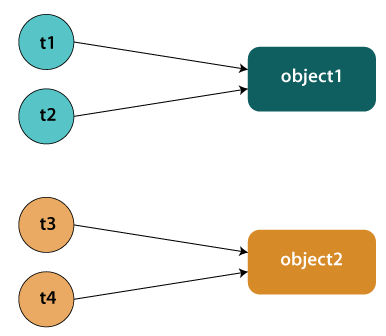Static SynchronizationIf you make any static method as synchronized, the lock will be on the class not on object.  Problem without static synchronizationSuppose there are two objects of a shared class (e.g. Table) named object1 and object2. In case of synchronized method and synchronized block there cannot be interference between t1 and t2 or t3 and t4 because t1 and t2 both refers to a common object that have a single lock. But there can be interference between t1 and t3 or t2 and t4 because t1 acquires another lock and t3 acquires another lock. We don't want interference between t1 and t3 or t2 and t4. Static synchronization solves this problem. Example of Static SynchronizationIn this example we have used synchronized keyword on the static method to perform static synchronization. TestSynchronization4.java Test it NowOutput: 1
2
3
4
5
6
7
8
9
10
10
20
30
40
50
60
70
80
90
100
100
200
300
400
500
600
700
800
900
1000
1000
2000
3000
4000
5000
6000
7000
8000
9000
10000
Example of static synchronization by Using the anonymous classIn this example, we are using anonymous class to create the threads. TestSynchronization5.javaHello Test it NowOutput:
1
2
3
4
5
6
7
8
9
10
10
20
30
40
50
60
70
80
90
100
100
200
300
400
500
600
700
800
900
1000
1000
2000
3000
4000
5000
6000
7000
8000
9000
10000
Synchronized block on a class lock:The block synchronizes on the lock of the object denoted by the reference .class name .class. A static synchronized method printTable(int n) in class Table is equivalent to the following declaration: Next TopicDeadlock In Java |

We provides tutorials and interview questions of all technology like java tutorial, android, java frameworks
G-13, 2nd Floor, Sec-3, Noida, UP, 201301, India










